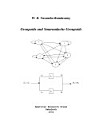Bilagebraic Structures and Smarandache Bialgebraic Structures
জানু ২০০৩ · Infinite Study
ই-বুক
270
পৃষ্ঠা
family_home
উপযুক্ত
info
reportরেটিং ও রিভিউ যাচাই করা হয়নি আরও জানুন
এই ই-বুকের বিষয়ে
Generally the study of algebraic structures deals with the concepts like groups, semigroups, groupoids, loops, rings, near-rings, semirings, and vector spaces. The study of bialgebraic structures deals with the study of bistructures like bigroups, biloops, bigroupoids, bisemigroups, birings, binear-rings, bisemirings and bivector spaces. A complete study of these bialgebraic structures and their Smarandache analogues is carried out in this book. For examples: A set (S, +, *) with two binary operations ?+? and '*' is called a bisemigroup of type II if there exists two proper subsets S1 and S2 of S such that S = S1 U S2 and(S1, +) is a semigroup.(S2, *) is a semigroup. Let (S, +, *) be a bisemigroup. We call (S, +, *) a Smarandache bisemigroup (S-bisemigroup) if S has a proper subset P such that (P, +, *) is a bigroup under the operations of S. Let (L, +, *) be a non empty set with two binary operations. L is said to be a biloop if L has two nonempty finite proper subsets L1 and L2 of L such that L = L1 U L2 and(L1, +) is a loop, (L2, *) is a loop or a group. Let (L, +, *) be a biloop we call L a Smarandache biloop (S-biloop) if L has a proper subset P which is a bigroup. Let (G, +, *) be a non-empty set. We call G a bigroupoid if G = G1 U G2 and satisfies the following:(G1 , +) is a groupoid (i.e. the operation + is non-associative), (G2, *) is a semigroup. Let (G, +, *) be a non-empty set with G = G1 U G2, we call G a Smarandache bigroupoid (S-bigroupoid) if G1 and G2 are distinct proper subsets of G such that G = G1 U G2 (neither G1 nor G2 are included in each other), (G1, +) is a S-groupoid.(G2, *) is a S-semigroup.A nonempty set (R, +, *) with two binary operations ?+? and '*' is said to be a biring if R = R1 U R2 where R1 and R2 are proper subsets of R and (R1, +, *) is a ring, (R2, +, ?) is a ring.A Smarandache biring (S-biring) (R, +, *) is a non-empty set with two binary operations ?+? and '*' such that R = R1 U R2 where R1 and R2 are proper subsets of R and(R1, +, *) is a S-ring, (R2, +, *) is a S-ring.
ই-বুকে রেটিং দিন
আপনার মতামত জানান।
পঠন তথ্য
স্মার্টফোন এবং ট্যাবলেট
Android এবং iPad/iPhone এর জন্য Google Play বই অ্যাপ ইনস্টল করুন। এটি আপনার অ্যাকাউন্টের সাথে অটোমেটিক সিঙ্ক হয় ও আপনি অনলাইন বা অফলাইন যাই থাকুন না কেন আপনাকে পড়তে দেয়।
ল্যাপটপ ও কম্পিউটার
Google Play থেকে কেনা অডিওবুক আপনি কম্পিউটারের ওয়েব ব্রাউজারে শুনতে পারেন।
eReader এবং অন্যান্য ডিভাইস
Kobo eReaders-এর মতো e-ink ডিভাইসে পড়তে, আপনাকে একটি ফাইল ডাউনলোড ও আপনার ডিভাইসে ট্রান্সফার করতে হবে। ব্যবহারকারীর উদ্দেশ্যে তৈরি সহায়তা কেন্দ্রতে দেওয়া নির্দেশাবলী অনুসরণ করে যেসব eReader-এ ফাইল পড়া যাবে সেখানে ট্রান্সফার করুন।








